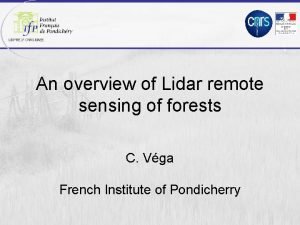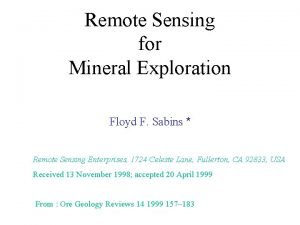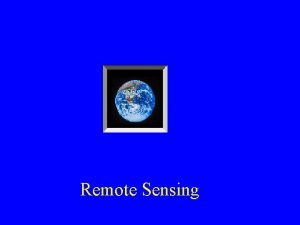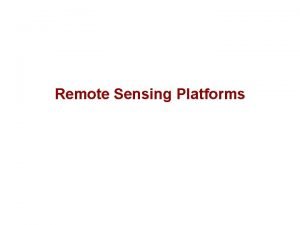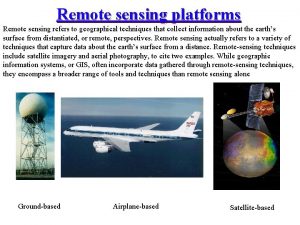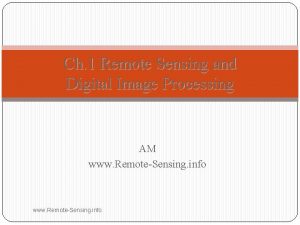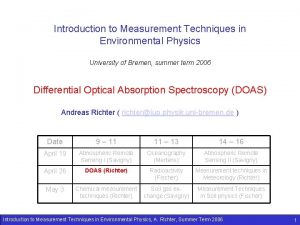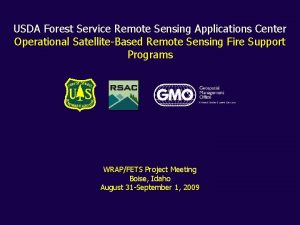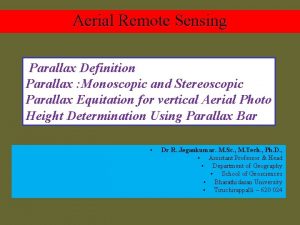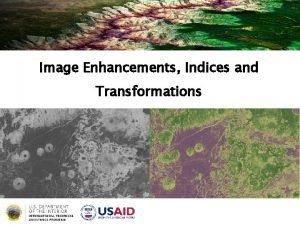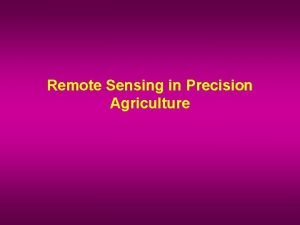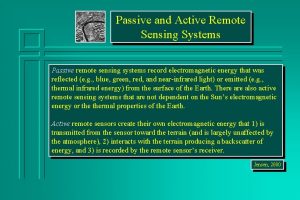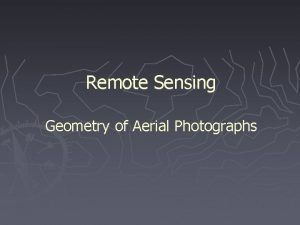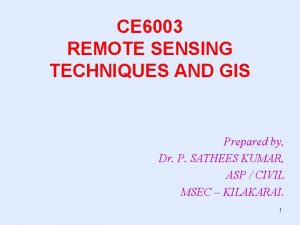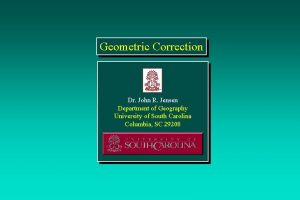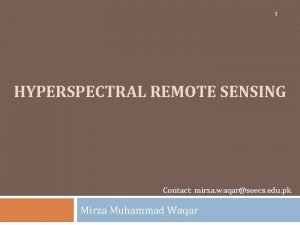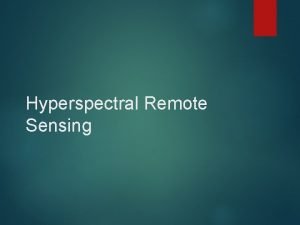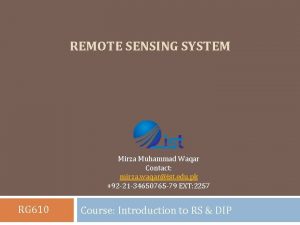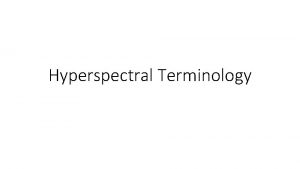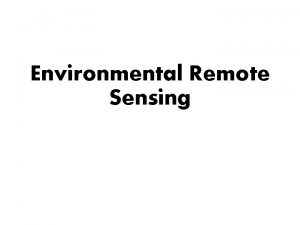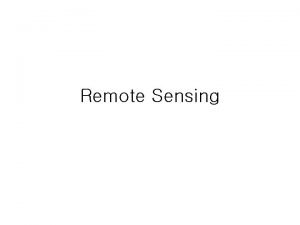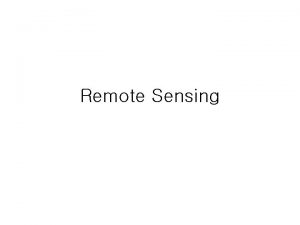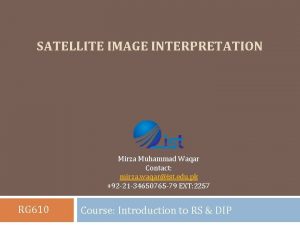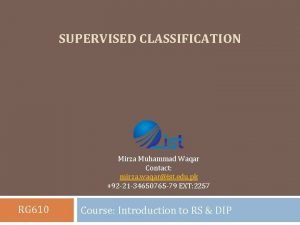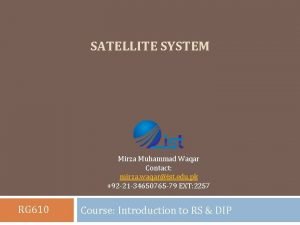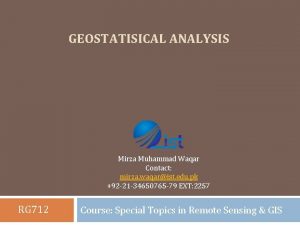1 HYPERSPECTRAL REMOTE SENSING SENSORS Contact mirza waqarseecs
















- Slides: 16

1 HYPERSPECTRAL REMOTE SENSING SENSORS Contact: mirza. waqar@seecs. edu. pk Mirza Muhammad Waqar

Contents 2 Hyperspectral Instruments o o o AVIRIS (Airborne Visible Infrared Imaging Spectrometer) CASI‐ 2 (Compact Airborne Spectrographic Imager‐ 2) Hyperion Hy. Map CASI

3

Hyperspectral Instruments 4 1. 2. 3. 4. 5. 6. 7. AVIRIS (Airborne Visible Infrared Imaging Spectrometer) MODIS (Moderate Resolution Imaging Spectroradiometer) CASI‐ 2 (Compact Airborne Spectrographic Imager‐ 2) Hyperion Daedelus Instruments Hy. Map CASI

AVIRIS (Airborne Visible Infrared Imaging Spectrometer) 5 The Airborne Visible Infra. Red Imaging Spectrometer (AVIRIS) was designed and built by the NASA Jet Propulsion Laboratory (JPL). It is a whiskbroom scanner, and it flies on several airborne platforms. The swath and spatial resolution depend on the flying height and over‐ground speed of the aircraft.

Cont… 6 On the NASA ER‐ 2 jet at 20 km above MSL, AVIRIS covers an 11 km swath at 20 m GSD. On a De. Haviland Twin Otter turboprop at 4 km AGL, AVIRIS covers a 2 km swath at 4 m GSD. 224 contiguous spectral channels Radiometric resolution: 12 bit

Note 7 AVIRIS is flown primarily for NASA‐funded scientists and researchers. Graduate students can obtain small amounts of existing AVIRIS data at no cost. http: //aviris. jpl. nasa. gov/data/grad_research. ht ml

8

CASI-2 (Compact Airborne Spectrographic Imager-2) 9 The Compact Airborne Imaging Spectrometer (CASI) is built by ITRES Research Ltd. , of Canada It can collect data in 14‐bit format for 288 bands at 2. 5 nm nomi However, the overall spectral range is limited to 650 nm, which is adjustable anywhere between 400 nm (blue) and 1050 nm (near‐IR). nal intervals. GSD in the range of 25 cm ‐ 1. 5 m

Hyperion 10 The Hyperion hyperspectral imaging sensor flies on the NASA Earth Observing‐ 1 (EO‐ 1) spacecraft launched in late 2000. Pushbroom technology gives Hyperion a longer target look time than a scanning radiometer, which helps to overcome the signal‐to‐noise problem.

11

Cont… 12 Features - Sensor type Pushbroom Orbit Sun synchronous – 1 minute behind Landsat Spectral bands 220 10 nm Spectral coverage 400 nm (blue) and 2500 nm (mid‐IR) Radiometric Resolution 12 bit Spatial Resolution 30 m

LEISA 13 Features - Spatial Resolution 250 m Spectral Resolution 246 in MIR portion Swath 185 km Applications Atmospheric Correction of other sensors

Hy. Map 14 Hy. Vista Corporation, of Sydney, Australia, commercially operates a 128‐band whiskbroom hyperspectral scanner. It operates in the familiar spectral range of 400 ‐ 2500 nm � but with a bandwidth of 15‐ 20 nm rather than 10 as for AVIRIS and Hyperion It records data in 12 ‐ 16 bit format. Spatial resolution range 3‐ 10 m.

Applications of Hyperspectral Data 15 1. 2. 3. 4. 5. 6. 7. 8. Atmosphere: water vapor, cloud properties, aerosols Ecology: chlorophyll, leaf water, cellulose, pigments Geology: mineral and soil types Coastal waters: chlorophyll, phytoplankton, dissolved Organic materials, suspended sediments, bathymetry Snow/ice: snow cover fraction, grain size, melting Biomass burning: subpixel temperatures, smoke Commercial: mineral exploration, agriculture and forest production

Questions & Discussion
 Lidar remote sensing for forestry
Lidar remote sensing for forestry Choropleth map example ap human geography
Choropleth map example ap human geography Advantages of remote sensing
Advantages of remote sensing Microwave remote sensing lecture notes
Microwave remote sensing lecture notes Remote sensing platforms
Remote sensing platforms Ifov and fov in remote sensing
Ifov and fov in remote sensing Limitations of remote sensing
Limitations of remote sensing Remote sensing physics
Remote sensing physics Remote sensing applications center
Remote sensing applications center Supervised classification
Supervised classification Image parallax in remote sensing
Image parallax in remote sensing Remote sensing
Remote sensing Remote sensing in precision agriculture
Remote sensing in precision agriculture Active passive remote sensing
Active passive remote sensing Geometry of aerial photographs
Geometry of aerial photographs Idealized remote sensing system
Idealized remote sensing system Geometric errors in remote sensing
Geometric errors in remote sensing
